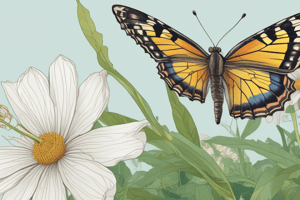Podcast
Questions and Answers
ما هو دور البذور في نباتات الزهور؟
ما هو دور البذور في نباتات الزهور؟
- الانتشار والبقاء (correct)
- تقديم المغذيات للأجنة
- تشكيل البويضات
- الاكتساب الطعام
ما الذي يحدث بعد نقل اللقاح إلى الحثّ؟
ما الذي يحدث بعد نقل اللقاح إلى الحثّ؟
- تتشكل البذور
- تنمو أجسام الأجنة
- تتكون البويضات
- يحدث التلقيح (correct)
ما هو التكاثر الخضري في النباتات؟
ما هو التكاثر الخضري في النباتات؟
- استخدام الريزومات فقط
- التكاثر بواسطة الديدان
- التكاثر الجنسي فقط
- التكاثر غير جنسي باستخدام وسائل خضرية (correct)
ما هو نسبة الأنواع النباتية المعرضة للانقراض وفقًا للجهود الحفظية؟
ما هو نسبة الأنواع النباتية المعرضة للانقراض وفقًا للجهود الحفظية؟
لماذا تبرز أهمية فهم دورة حياة النباتات المزهرة؟
لماذا تبرز أهمية فهم دورة حياة النباتات المزهرة؟
Flashcards
Seed Germination
Seed Germination
The beginning of a flowering plant's life where the seed breaks open and the embryo starts growing, developing roots and a shoot.
Vegetative Growth
Vegetative Growth
The stage where a plant grows stems and leaves, increasing in size and complexity, capturing sunlight for photosynthesis.
Pollination
Pollination
The process of transferring pollen from the male part (stamen) of a flower to the female part (pistil), enabling fertilization and seed formation.
Fertilization
Fertilization
Signup and view all the flashcards
Vegetative Reproduction
Vegetative Reproduction
Signup and view all the flashcards
Study Notes
Understanding Flowering Plants and Their Life Cycle
Flowering plants, also known as angiosperms, are the largest and most diverse group of land plants. With over 300,000 known species, they play a crucial role in our daily lives and ecosystems. From providing food and medicine to serving as decorative elements in our homes and public spaces, understanding the life cycle of flowering plants is essential for appreciating their importance.
Stages of a Flowering Plant's Life Cycle
Seed Germination:
When a seed comes into contact with suitable conditions for growth, it begins to break open and the embryo inside starts to grow. Roots emerge from the seed and gradually anchor the plant into the ground. Simultaneously, a shoot grows skyward and eventually becomes the stem, supporting leaves and transporting water and nutrients from the roots to the rest of the plant ().
Vegetative Growth:
As the young plant grows, it develops stems and leaves, which serve various functions such as capturing sunlight for photosynthesis. Over time, the plant may reach maturity and begin producing flowers.
Reproduction:
Once mature, the plant enters the reproductive phase. During this stage, it develops flowers that participate in sexual reproduction. Flowers consist of male and female reproductive structures, such as stamens (male) and pistils (female).
Pollination:
The process by which pollen is transferred from the male part of a flower to the female part involves two steps: fertilization and seed formation. Insects or wind can transport pollen to the stigma of another flower within the same species, where it eventually moves down to the ovary where fertilization occurs ().
Fertilization:
Upon successful pollination, the male gametes (pollen grains) fuse with the female gametes (ovules), forming a diploid zygote. This zygote grows into an embryo within a seed formed by the ovule. Seeds are essential for the plant's dispersal and survival, as they contain all the necessary components for new growth when conditions are suitable ().
Vegetative Reproduction:
In addition to sexual reproduction, some plants reproduce asexually through vegetative means, such as stolons or rhizomes. These structures allow the plant to produce new shoots that grow independently of the parent plant, creating clones with identical genetic information ().
Conservation Efforts
Despite their prevalence and importance, many flowering plant species are threatened by human activities like habitat loss, logging, collection of medicinal plants, and the introduction of non-native invasive species. Organizations such as IUCN and Royal Botanic Gardens, Kew suggest that approximately 40% of plant species are at risk of extinction due to these factors ().
Understanding the life cycle of flowering plants not only helps us appreciate their role in our ecosystem but also highlights the need for conservation efforts to protect them. By preserving these diverse organisms, we ensure future generations will continue to benefit from their abundant offerings.
Studying That Suits You
Use AI to generate personalized quizzes and flashcards to suit your learning preferences.
Description
هذا الاختبار يقدم معلومات حول نباتات الزهور ودورتها الحيوية، بدءًا من تكوين البذور ونمو النبات إلى المرحلة الإنجابية وأهمية الحفاظ على هذه الكائنات المتنوعة. يسلط الضوء على العمليات مثل التلقيح والانتشار لهذه النباتات والجهود الرامية للحفاظ عليها.




